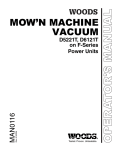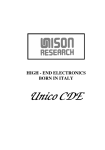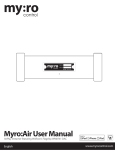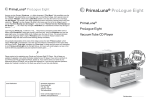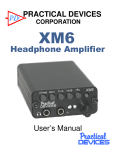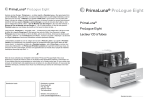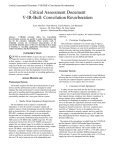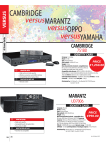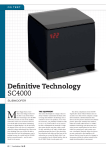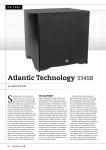Download Unison Research Unico CD Primo
Transcript
ON TEST Unison Research Unico CD Primo cd player T he Italians have a reputation for unique design, and Unison’s Unico CD Primo CD player is not going to do anything to dispel it: it’s a most unusual design—dare I say ‘unique’? For me, the single aspect of the design that is most likely to polarise buyers’ opinions will be the large wooden ellipse with the metallic ‘UR’ initials that is inset in the front panel. You’re either going to love it or hate it. I may reveal my own thoughts on the matter further on in this review, but in the meantime, my first thought on seeing it was: ‘What were they thinking?’ That aside, a feature of the CD Primo that will be loved by all is that it has a USB input, so that if you have music files stored on your computer (32kHz, 44.1kHz or 48kHz sample rate only), you can use the Primo as an external DAC. The Equipment Despite its ability to be used as an external DAC, the CD Primo’s prime purpose is to play CDs, and it’s set up very well to do that, with a neat slot-loading CD tray at the left side of the front panel, towards the top. Located just off-centre to the right is a very large—and I mean very large!—front panel display. Off to the right of this display is a circular window that doubles as an infra-red receiver, to pick up commands from the supplied IR remote, and a light sensor that alters the brightness of the main front panel display according to how much ambient light is in the room. The transport controls rather oddly, but very artistically, sweep downwards from the IR window, starting with the Eject button, and continuing through the Play/Stop button, then the Track Search (Reverse) and Track Search (Forward) buttons. As you can see, you only get the basics if you don’t use the remote! Actually, you don’t get a whole lot more control over the player even if you do use the remote, but it does add the ability to change the time display on the front panel, access the two repeat modes and get direct access to tracks by using numeric buttons to select particular tracks. One advantage of using the remote is that you won’t have to touch the front panel of the CD Primo. This is an advantage because I found the surface finish Unison Research uses on the black version picked up fingerprints very easily… yet they weren’t as easy to remove. The silver version is easier to keep clean! The rear panel of the Unison Research is quite bare: just a single co-axial digital output connector (gold-plated RCA), a USB connector (device), a pair of gold-plated unbalanced analogue outputs (RCA) and a standard IEC 240V mains power socket. Harking back to the fact that you can also use the CD Primo as an external DAC, it will also have another—fairly esoteric!—application in some systems that already have an external DAC, but one without a USB input. If this sounds like your system, you can actually add the CD Primo into this chain in such a way that your computer connects via USB to the Primo CD, after which you can link the Primo CD’s digital output to the digital input of your DAC! In other words, the Primo manages the USB-to-digital conversion and your external DAC takes care of the final digital-to-analogue conversion. Internals Lifting the lid on the Unison Research Unico CD Primo revealed that Unison Research has put the digital-to-analogue conversion circuitry on a completely separate plug-in printed circuit board (populated with surface mount devices) presumably so that if an improved DAC comes along, upgrading your Primo will be simply a matter of unplugging one PCB and plugging in another (no soldering required). However, I can also appreciate that it would make servicing very easy. On this removable PCB is a Wolfson Micro WM8804 digital interface, a Burr Brown SRC4192 sample rate converter and a Wolfson WM8524 digital-to-analogue converter. The analogue output board sports a single Electro-Harmonix 12AU7A triode and operates in Class A. The transport is a Teac CD5010A (CD-ROM transport), which Teac claims is fitted with a low-jitter mechanism it developed specifically for high-end audio applications. Operation and Listening Sessions If you have never owned a valve product previously, you might find it slightly annoying that you can’t use the Unico CD Primo for at least 30-seconds after switching it on, because it locks you out while the valve is warming up. At least Unison Research makes sure there’s a friendly ‘Valve Warm Up’ message in the front panel display, as well as a timer count-down so you know how long you have to wait before you can load a disc—or, if one is already loaded, before you can start to play it. However, being a valve unit, you will also have to wait a little longer before the CD Primo will sound its best, which is after the valve has reached its optimum operat- avhub.com.au 51 ON TEST Unison Research Unico CD Primo CD Player ing temperature. Unison Research says this is 10 minutes, but I found that 20 minutes was closer to the mark—though it was winter when I was auditioning, and my room was relatively cold. Presumably things would speed up in summer. Of course it isn’t only valve equipment that needs to reach operating temperature to perform at its best—this also applies to solid-state equipment. In the case of the Primo, the valve actually speeds up the process for the solid-state components, because it ‘warms’ the inside of the case… which in turn warms up the solid-state devices more quickly. The slot-loading CD tray seems to have inherited Teac’s transport logic board as well, Short History Unison Research isn’t a well-known brand in Australia, so a brief history is probably in order. The company is Italian, and all its products are still made in Italy. The company was founded in 1987 by a small group of audiophiles, led by Giovanni Maria Sacchetti, which dedicated itself to building esoteric valve amplifiers. The product that put Unison Research on the radar of audiophiles around the world was the company’s second attempt at an integrated amplifier, the Simply Two. This 12-watt per channel amplifier, which used a single-ended Class-A output stage, became a cult amplifier in Japan and in total sold around 10,000 units worldwide before it was superseded. Its success not only put Unison Research on the map, but also marked the beginning of a long series of projects based aaround single-ended Class-A output stages. The company restructured in 1998, becoming part of an outfit known as Advanced Research In Audio Ltd (A.R.I.A.) though Sacchetti remained with the new company, as director of R&D, A.R.I.A. decided that Unison Research products should include some solid-state designs, and to help achieve this, partnered with one of Italy’s most prestigious universities, the University of Padua, on a project aimed at developing some hybrid (valve/solidstate) designs. The project, which was headed by Professor Leopoldo Rossetto, resulted in several new models for Unison Research, the first of which was the SR1, which was followed by the Unico series of hybrid valve/MOSFET designs. G.B. because if the tray is obstructed on its way out the CD Primo just stops working completely and you have to turn it off and then back on again to ‘clear’ the logic IC. This wouldn’t normally be a problem, except that the 30-second ‘warm-up’ routine isn’t linked to a thermal sensor, so the timer countdown is invoked every time you turn the player on. If you mis-load a CD so the tray can’t close properly the drawer re-opens automatically, but then becomes ‘locked’ in the open position and when this did happen, the only way I could get it to close was to push the drawer lightly: a trick the manual specifically recommends against playing. It seems you need to make sure the drawer is not obstructed in any way. Another foible of Teac’s drawer logic is that if you press ‘Eject’ immediately after the door has closed without there being a disc in the tray, the CD Primo will freeze with the word ‘Eject’ showing in the display. Again, the only cure I could find was to turn the machine off, and then back on again… and then wait yet another 30 seconds for it to ‘warm-up’. The good news is that although the CD Primo’s tray has the usual edge supports for both 8cm and 120cm CDs (I don’t know why they still persist in building 8cm rims, because I haven’t seen a single 8cm CD for more than a decade… indeed I didn’t even know they were still making them!) it also has excellent angled ‘disc guides’ that make it almost impossible—I’d say ‘impossible’ except that I want to cover myself—to misload a CD. Basically, if you drop a CD anywhere over the tray, the angled guides will ‘snick’ it into the correct position in a jiffy. Once loaded, the CD Primo reads the disc’s table of contents (TOC) relatively slowly (around 15 seconds), after which it displays the word ‘STOP’ along with the total number of tracks on the disc and the total playing time, on the front panel display. The display itself is quite unusuallyshaped, as you can see from the photograph accompanying this review, and it’s also a rather unusual murky-green colour. I think I’d rather a nice blue display, but I suppose green is very ‘environmental’. Once you have started playing a disc, you can then change the display to show elapsed time for the current track, elapsed playing time on the disc or the remaining playing time on the disc, but you will need the remote control to do this: it can’t be done from the front panel. However, even though I wasn’t keen on the green colour of the display, I couldn’t fault the size of the writing in the display: the letters and numerals are 1cm high! The only pity is that all the lettering is in capitals—a combination of upper and lower-case lettering would be much easier to read. As mentioned previously, the remote also gives access to the CD Primo’s only two repeat modes, which are ‘Repeat Track’ and ‘Repeat Disc’. There is no A–B repeat function. No track programming features are available either—either from the front panel or the remote. Direct track access is the only convenience feature, and for this you’ll need to use the numeric keys on the remote control. Although most of the transport buttons operate in the usual manner (Next Track, Previous Track, Scan Forward, Scan Reverse, and so on) the combined Play/Stop button had me flummoxed. It seemed to act more like a Play/Pause button, because I just couldn’t seem to make the player just ‘Stop’. It either simply paused itself, or jumped back to the start of whatever track was playing—I couldn’t get it to go back to the start of the disc for a true ‘Stop’. It was only when I finally read the manual (yes, I know… when all else fails, read the &*^%$ manual!) that I discovered the button has a rather snazzy Unison Research Unico CD Primo Brand: Unison Research Model: Unico CD Primo Category: CD Player RRP: $2,899 Warranty: Two Years Distributor: Radiance AudioVisual Address: Unit 33. 5 Gladstone Street Castle Hill, NSW 2154 (02) 9659 1117 (02) 9659 1116 [email protected] www.radianceav.com.au • USB Input • Digital Ouput • Large display • Drawer Logic • ‘Push’ button • Black panel finish LAB REPORT Readers interested in a full technical appraisal of the performance of the Unison Research Unico CD Primo CD Player should continue on and read the LABORATORY REPORT published on page 54. Readers should note that the results mentioned in the report, tabulated in performance charts and/or displayed using graphs and/or photographs should be construed as applying only to the specific sample tested. Lab Report on page 54 52 Australian Unison Research Unico CD Primo CD Player logic built in. If you press it briefly, as I was, it acts like a Play/Pause control. However, if you hold the button down for one second, the player goes back to the start of the track. If you then press and hold the button down for one full second, it is only then that the CD Primo will reset itself right back at the start of Track 1. I personally think that since this isn’t a ‘typical’ operation mode, it would have been nice if Unison Research had made a special point of mentioning this operation at the start of the ‘Track Selection’ section of the manual, rather than leaving it until the end! That said, maybe this is ‘normal’ operation for Italianmade CD players, because yet another weird function of the CD Primo is the ‘Push’ button on the remote. And by this, I don’t mean a ‘push-button’, I mean a button that is labelled ‘Push’! No doubt it’s some type of translation issue, but I was reminded of the starship Heart of Gold in Douglas Adams’ novel Hitchhiker’s Guide to the Galaxy, which has on its control panel a button marked ‘Don’t Push This Button!’ (Actually, when this review was being proof-read it turned out my own memory was misfiring, because in the book, the button was not so labelled. Adams’ exact words were: ‘He reached out and pressed an invitingly large red button on a nearby panel. The panel lit up with the words “Please do not press this button again”.’) Anyway, what the ‘Push’ button on the Unison Research’s remote does when it’s pushed is bring up the ‘Advanced’ menu on the display, which then shows the following: 2: UnicoCDPrimo Not very intuitive, is it? If you then press the ‘2’ button on the remote, the display will reward you by switching to show: 1: Reset DAC 2: USB input 3: Display OFF 4: Reset ALL From this display, if you press (2) you’ll select the USB input or (3) and you’ll switch the display off. The manual warns against selecting either (1) or (4) because (to quote verbatim): “this features only is needed for troubleshooting and improper use is not advisable.” To exit either of these two menus, you need to press the button marked ‘Push’. (Of course!) And so to how I found the sound of the Unico CD Primo. Over the years I have gradually formed the impression that a few companies that manufacture valve equipment do so primarily so they can put the word ‘valve’ or ‘tube’ in the model name merely so they can appeal to a particular sector of the market. Products designed in such a fashion may pay ‘lip-service’ to the concept, but they rarely actually sound like true ‘valve’ components. I can tell you quite emphatically that simply listening to just one CD played back on the Unico CD Primo will be proof positive that Unison Research is not one of these ‘me-too’ companies. To the contrary, the Unico Primo is one of the ‘valve-vee-est’ CD players it’s ever been my pleasure to hear… and it truly was a pleasure. One thing is for certain, and that is that anyone who has ever complained about the CD format sounding ‘brittle’ and ‘hard’ should immediately rush out to audition the Unico CD Primo, because its sound could never, ever, be characterised by such descriptions. Play a CD and you’ll hear an all-enveloping warmth to the sound, so that your loudspeakers will present you with what is, in essence, a sonic banquet. One of the first discs I span up was the latest Kasey Chambers album ‘Little Bird’ (I couldn’t say I am a fan, but she’s growing on me and I do find her music interesting) and found that the CD Primo sound is so rich that it even ‘warmed-up’ Casey’s rather thin-sounding voice (which is made even thinner by being recorded fairly dry on this CD) and what it did to the harmonies—overdubbed and otherwise—was just breathtaking. There are some great acoustic guitar sounds on this album (Beautiful Mess is a perfect example) and the Unico embellishes this as well. (This is a great CD by the way: even if you’re not usually a Kasey fan I think you’ll find much to like on it.) But how would the Unico CD Primo fare with more complex fare? Brilliantly, is the ON TEST answer. Julian Yu’s ‘Pictures at an Exhibition, Reflected and Refracted’ with the Australian Pro Arte Chamber Orchestra has a wonderful palette of orchestral colours combined with Move’s usual superb recording techniques and I don’t think I’ve ever heard it sound better than I did when I played it on Unison Research’s CD Primo. It wasn’t just the tone of the individual orchestral instruments—in particular the lovely viola sound that is used to represent Mussorgsky wandering through the exhibition of his dead friend’s paintings— but the surprising music effects (and musical jokes!) the Yu uses throughout. Again, if you think you have heard Mussorgsky’s Pictures at an Exhibition, grab a copy of this disc (Move MD3312) and discover a completely new work that is endlessly fascinating and inventive—and if you’re not ‘into’ classical music, even more reason to buy, because it will open a window for you. Dialling up something a little rockier, Little Red’s new ‘Midnight Remember’ CD showed the Unico Primo won’t ‘lose it’ if you throw it some over-produced, super-busy tracks with hard-hitting bass lines. However, musically the CD shows that Little Red hasn’t really gone in any new direction, with nearly every track causing me to think ‘haven’t I heard this before somewhere?’ But I shouldn’t give LR too hard a time— that it seems to be a National sport these days—and I did like the track Lazy Boy, so 1 out of 13 ain’t bad. A disc I thought would sound absolutely wonderful when played on the Unico CD Primo was yet another new Move disc titled ‘Mendelssohn Cello’ which has Zoe Knighton (cello) and Amir Farid (piano) playing Mendelssohn’s Sonata for Cello and Piano No 1 in B Flat Major (Op 45) and No 2 in D Major (Op 58) as well as Songs without Words for Cello and Piano (Op 109). Again I was not disappointed: indeed the opposite… completely entranced. So much so that once this disc started, I remained transfixed in my seat, as still, silent and admiring as if I’d been at the original premieres. Conclusion As you have no doubt gathered, this is a quirky CD player with a real personality (and look) that’s all its own but hey, it’s Italian, so think Alfa Romeo, Vespa, Ferrari, Ducati and… umm Peroni… and rejoice in the fact that this is a CD player that will make your CDs sound better than they ever have before. greg borrowman avhub.com.au 53 LAB REPORT Unison Research Unico CD Primo CD Player SEE REVIEW ON PAGE 51 Test Results That the Unison Research’s Unico Primo CD has a valve in its output stage was obvious right at the outset, from one of the very first ‘on-the-bench’ tests that Newport Test Labs performs, which is shown in Graph 1: namely total harmonic distortion (THD) at 0dBFS recorded level. As you can see, there’s a very prominent second harmonic component visible at –53dB (0.22% THD) that’s directly attributable to the 12AU7 triode. There are also a few higher-order harmonics, but the third and fifth are the only ones higher than –100dB, at –93dB (0.002%) and –98dB (0.001%) respectively. In some cases, distortion at 0dBFS is caused by the output stage being overdriven, because many CD player manufacturers now optimise their output stages for recorded levels of around –10dBFS, because this is more in line with the typical ‘highest’ levels found on most commercial music CDs. However, you can see from Graph 2, which shows THD re –10dBFS, that in the case of the Unico Primo, the second harmonic distortion is still relatively high, at an absolute level of –73dB, or a relative level of –63dB (0.07%) when referenced to actual output level. Note that at this lower level, there is only a single third harmonic distortion component visible above the noise floor, at –110dB (0.0003%). Note also that the noise floor itself is a long way down, at better than –120dB, so Unico’s digital-to-analogue conversion is excellent in this regard. You can see, however, that some mains-related noise components are visible the charge-pump DAC architecture used by Wolfson Micro in its WM8524, which seems to produce a much cleaner noise floor than Burr Brown’s oversampling DACs to the left of the fundamental, but they’re mostly still more than 100dB down (0.001%). Graph 3 shows the Unison Research CD Primo’s performance with a –60dBFS signal and you can see that it has quite a clean noise floor, which I’d attribute to the charge-pump Unison Research CD Primo CD Player Analogue Section Output Voltage Result 2.1786 / 2.1769 Frequency Response 20Hz to 20kHz +/–0.15dB Channel Separation 76 / 75 / 53 THD+N Channel Balance Channel Phase Group Delay Signal-to-Noise Ratio (No Pre-emph) De-Emphasis Error Units/Comment volts (Left Ch/ Right Ch) dB (20Hz – 20kHz) dB at 16Hz / 1kHz / 20kHz 0.13% @ 1kHz @ 0dBFS 0.006dB @ 1kHz @ 0dBFS 0.07 / 0.00 / 0.06 degrees at 16Hz / 1kHz / 20kHz +176.23 / –14.42 degrees (1–20kHz / 20–1kHz) 91 / 98 dB (unweighted/weighted) 0.37 / 3.50 / 8.80 at 1kHz / 4kHz / 16kHz Linearity Error @ –60.00dB / –70.00dB 0.02 / 0.04 dB (Test Signal Not Dithered) Linearity Error @ –80.59dB / –85.24dB 0.05 / 0.09 dB (Test Signal Not Dithered) Linearity Error @ –89.46dB / –91.24dB 0.18 / 0.15 dB (Test Signal Not Dithered) Linearity Error @ –80.70dB / –90.31dB 0.06 / 0.10 dB (Test Signal Dithered) Power Consumption N-A / 39.9 watts (Standby / On) Mains Voltage During Testing 242 – 256 volts (Minimum – Maximum) Digital Section Result Units/Comment Digital Carrier Amplitude 264mV Audioband Digital Carrier Amplitude 1.09V / 3.2V Differential / Common Mode Audioband Jitter 29.6 / 0.143 nS (p–p) / UI (p–p) Data Jitter 39.4 / 0.194 nS (p–p) / UI (p–p) Deviation 1154.5 Frame Rate ppm 44150.929 Eye-Narrowing (Zero Cross) 41.3 / 0.165 nS (p–p) / UI (p–p) Eye-Narrowing (200mV) 59.8 / 0.247 nS (p–p) / UI (p–p) Inverted Normal / Inverted Absolute Phase Bit Activity at Digital O/P 54 Australian 23 Where Fitted DAC architecture used by Wolfson Micro in its WM8524, which seems to produce a much cleaner noise floor than Burr Brown’s oversampling DACs. This exemplary performance continues down at –80.59dBFS, as you can see for yourself in Graph 4, however it appears that the many of the distortion components are uncorrelated with the 1kHz test signal. However, this is of academic interest only, since it’s an undithered signal, whereas signals from commercial CDs are always dithered, and also because all the components are more than 110dB down. Performance with a dithered 1kHz test signal is shown in Graph 5 and you can see there are no distortion components visible above the noise floor at all (though the mains-related noise components are still present below 1kHz, as you can see at the extreme left of the graph). I noted a small ‘blip’ on the trace at around 6.2kHz, which may be an artefact of the Unico itself, or evidence of some unwanted interaction between the Primo and the test equipment. I wasn’t able to get an answer on this, because the lab had already returned the CD player to the distributor when I rang, but even if it was the Primo causing the glitch all on its own, it’s not significant, being nearly 120dB down (equivalent to a distortion level of around 0.0001%.) The noise/distortion spectrum becomes more ‘typical’ of digital-to-analogue conver- Unison Research Unico CD Primo CD Player sion with an undithered test signal at a recorded level of –91.24dB, as shown in Graph 6, but all distortion components are more than 100dB down. The noise floor itself reduces to –130dB, which is excellent. As expected, dithering the test signal eliminated the distortion components almost completely (Graph 7) at the expense of a slight lift in the level of the noise floor, but in this case it’s still sitting down below –120dB. This time around, I can tell you that the ‘blip’ of signal just under 16kHz was due to a nearby computer monitor, so you can ignore it! dBFS 0.00 Newport Test Labs Due to the use of a valve in the output stage, I’d expected to see some regenerated 1kHz signal when Newport Test Labs tested the CD Primo with a CCIF (twin-tone) IMD signal, and it performed exactly as I expected, with the signal just 60dB below reference. There are also some sidebands clustered around the 19kHz and 20kHz test signals, but all are more than 100dB down. Note that the noise floor does not rise at frequencies higher than 20kHz, which is a definite plus for the Wolfson DAC. There are a few unwanted high frequency signals visible up around 38kHz dBFS 0.00 -20.00 -20.00 -40.00 -40.00 -60.00 -60.00 -80.00 -80.00 -100.00 -100.00 -120.00 -120.00 Newport Test Labs -140.00 -140.00 0.00 Hz 4000.00 8000.00 12000.00 16000.00 0.00 Hz 20000.00 dBFS 0.00 4000.00 8000.00 12000.00 16000.00 20000.00 Graph 2. THD @ 1kHz @ -10dB recorded level. [Unison Research CD Primo Player] Graph 1. THD @ 1kHz @ 0dB recorded level. [Unison Research CD Primo Player] Newport Test Labs -20.00 -40.00 -60.00 -80.00 -100.00 -120.00 -140.00 0.00 Hz 4000.00 8000.00 12000.00 16000.00 20000.00 Graph 3. THD @ 1kHz @ -60dB recorded level. [Unison Research CD Primo Player] dBFS 0.00 Newport Test Labs dBFS 0.00 -20.00 -20.00 -40.00 -40.00 -60.00 -60.00 -80.00 -80.00 -100.00 -100.00 -120.00 -120.00 -140.00 Newport Test Labs -140.00 0.00 Hz 4000.00 8000.00 12000.00 16000.00 20000.00 Graph 4. THD @ 1kHz @ -80.59dB recorded level. (No dither) [Unison Research CD Primo] 0.00 Hz 4000.00 8000.00 12000.00 16000.00 20000.00 LAB REPORT that don’t seem to be related to the sampling frequency or the test signal but either way, they would not be audible because of their high frequency and their low level. The frequency response (Graph 9) of the CD Primo was very flat, particularly up to 4kHz, but was 20Hz to 10kHz ±0.025dB. Above 10kHz the response ‘rolls off’ quite steeply, as you can see on the graph, seemingly due to Unison Research including the external analogue low-pass filter recommended by Wolfson Micro. However, the extent of this ‘roll-off’ is exaggerated by the vertical scale of the graph supplied by Newport Test Labs, which as you can see, is +0.2dB at its top and only –0.2dB at its bottom, for a total display range of ±0.2dB In fact, the Unison Research CD Primo’s frequency response was only 0.15dB down at 20kHz, so its overall response (as measured by Newport Test Labs) is actually 20Hz to 20kHz ±0.15dB. This same frequency response is also reflected in Graph 10, which shows the Unico CD’s performance with the famous ‘Impulse Train’ (a test signal developed by Philips that has one maximum amplitude positive sample every 70 samples, for a signal that produces 630 pulses per second.) Newport Test Labs measured the CD Primo’s output voltage as being just about exactly on average, at around 2.17 volts, and channel balance was a stunningly good 0.006dB! Interestingly, channel separation, although far in excess of what is required to produce stunningly good stereo signals, falls quite a bit short of most other CD players the lab has measured in recent times, and most especially so at midrange and low frequencies, so I assumed this was in part another side-effect of using a valve in the output stage. However, inter-channel phase was also excellent, as you can see from the tabulated results. The overall signal-to-noise ratio was obviously influenced by the low-frequency mains hum components I noted when commenting on THD, because it came in at 98dB with ‘A’ weighting. This is nonetheless Graph 5. THD @ 1kHz @ -80.70dB recorded level. (With dither) [Unison Research CD Primo] avhub.com.au 55 LAB REPORT Unison Research Unico CD Primo CD Player if you’re one of those audiophiles who maintains they can actually hear absolute signal polarity, you will need to swap over your speaker cables dBFS 0.00 Newport Test Labs dBFS 0.00 -20.00 -20.00 -40.00 -40.00 -60.00 -60.00 -80.00 -80.00 -100.00 -100.00 -120.00 -120.00 -140.00 Newport Test Labs -140.00 0.00 Hz 4000.00 8000.00 12000.00 16000.00 20000.00 0.00 Hz dBFS 0.00 4000.00 8000.00 12000.00 16000.00 20000.00 Graph 7. THD @ 1kHz @ -90.31dB recorded level. (With dither) [Unison Research Primo] Graph 6. THD @ 1kHz @ -91.24dB recorded level. (No dither) [Unison Research CD Primo] Newport Test Labs -20.00 -40.00 -60.00 -80.00 -100.00 -120.00 -140.00 0.00 Hz 9600.00 19200.00 28800.00 38400.00 48000.00 Graph 8. CCIF Distortion (Twin-Tone Intermodulation) @ 1kHz @ 0dB using 19kHz and 20kHz test signals in 1:1 ratio. [Unison Research CD Primo Player] dBFS 0.20 Newport Test Labs 0.15 dBFS 0.00 Newport Test Labs -20.00 0.10 -40.00 0.05 -60.00 0.00 -80.00 -0.05 -100.00 -0.10 -0.15 -120.00 -0.20 20.56 Hz 100.00 1000.00 10000.00 Graph 9. Frequency Response at @ 0dB recorded level. [Unison Research CD Primo] 56 Australian -140.00 0.00 Hz 9600.00 19200.00 28800.00 38400.00 48000.00 Graph 10. Impulse Train. (One maximum amplitude positive sample every 70 samples (630 pulses per second). [Unison Research CD Primo Player] excellent, and better than many amplifiers can manage even when operated at their rated power output. The de-emphasis testing conducted by the lab showed that either the Wolfson Micro DAC does not support de-emphasis, or that it does but Unison Research has not implemented it. This will only be significant if you own a great many CDs that were mastered and pressed in the early 1980s, because it was only back then that de-emphasis was applied during recording. If you do play back emphasised discs on the CD Primo, they will sound too bright, which you can correct by turning your treble control (if you have one!) anti-clockwise. However, speaking of ‘tweaks’ you might have to make during playback, the Unison Research CD Primo’s analogue output inverts absolute phase, so if you’re one of those audiophiles who maintains they can actually hear absolute signal polarity, you will need to swap over your speaker cables so that the left (–) speaker output terminal on the amplifier goes to the (+) terminal on the left speaker, and the left (+) terminal from the amplifier goes to the (–) terminal on the left speaker, and then do the same thing for the right speaker. I would not bother doing this, because (a) I don’t believe it’s possible to hear the difference between absolute and inverted polarity when listening to music and (b) I think that around 50 per cent of commercially available CDs are recorded with ‘reverse’ absolute polarity anyway, so however you wire your system, you will still be wrong 50 per cent of the time! Linearity error was very low, as you can see from the tabulated listing, but power consumption was quite high, again presumably the result of including the valve in the output stage. I was surprised that the Primo CD does not have a standby mode: the company will obviously have to include one when the Australian government introduces its mandatory power-saving legislation in 2012! The signal from the digital outputs of the Primo didn’t seem to match the Teac transport’s claims for ‘low jitter’ because both audioband jitter (29.6nS) and data jitter (39.4nS) were quite high, and deviation was higher than I have ever seen on any CD transport (1154.5ppm). The eyenarrowing figures were also very high, at 41.3nS (zero cross) and 59.8nS (200mV). Of the two spectrograms that accompany this review, one shows a pulse exhibiting the reversed absolute polarity I discussed previously, while the second shows a 1kHz square wave that demonstrates the typical time-reversed ringing of a standard oversampling digital filter. Steve Holding AD 57







